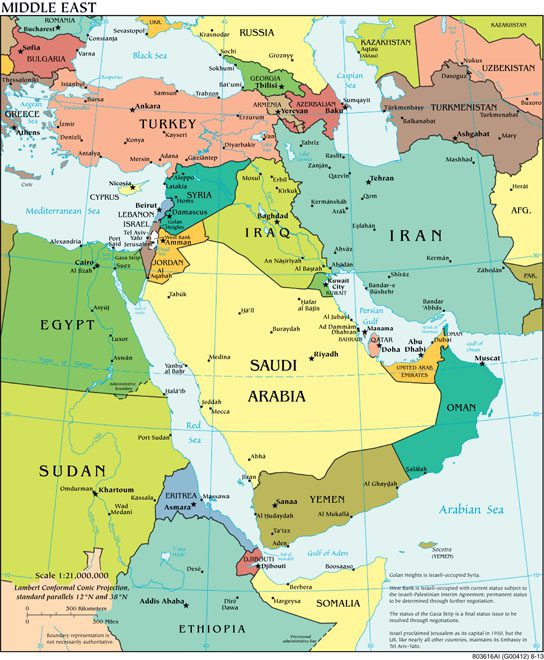
Every once in a while, I’m asked to explain the difference between the terms Near East and Middle East.
You may not have asked. You may not even care. But I’ll attempt an explanation here nonetheless. My comments aren’t based on specific research, which would be interesting to pursue, but simply on my sense of things after years of being in and around the academic field.
Originally, I think, the terms Near East and Middle East were introduced along with the term Far East, which we obviously still use (roughly) for East Asia. They’re quite manifestly Eurocentric expressions, because they categorize countries and places according to their nearness to or distance from Europe (specifically cities like London and Paris, and academic centers such as Oxford, Cambridge, Paris, and Berlin). Curiously, though, the terms have caught on in the region itself: Arabic speakers describe themselves as living in al-sharq al-awsat (“the Middle East”) or, less commonly, al-sharq al-adna (“the Near East”). The late great Marshall Hodgson tried to replace them with substitutes such as “the Nile-to-Oxus region,” but his neologisms, while they make eminent sense, haven’t really caught on.
Another problem with the terms is that, in fact, Morocco (which is almost always, but — weirdly — not quite inevitably, included in the Near East or the Middle East), is actually situated to the west of France.
The “Near East” was probably originally intended to include Turkey, North Africa, and the Arab world. The “Middle East” probably contained Iran, Afghanistan, modern Pakistan, India, etc. The last three are almost never included today. And the Far East was and still is the Far East.
Today, though, Middle East and Near East are essentially synonymous. At least, I can’t tell the difference between them. My degree from UCLA is from the Department of Near Eastern Languages and Cultures. Had I attended the University of Utah, though, the equivalent degree would have been supervised by the Middle East Center. At BYU, I teach Arabic courses in the Department of Asian and Near Eastern Languages, but my students who major in the field graduate in Middle East Studies (Arabic).
Sometimes, oddly, Morocco and Algeria and Tunisia and Libya are excluded from the “Middle East.” (Perhaps there’s a lingering influence here of the “Near East,” but I’m not sure about that. They may also be omitted from the “Near East”; I haven’t done a systematic study of this.) And, sometimes, Pakistan and Afghanistan and, very strangely, even Armenia and Greece are included.
I hope that clarifies things. Or, at least, that it confuses you in an appropriate and satisfying way.











